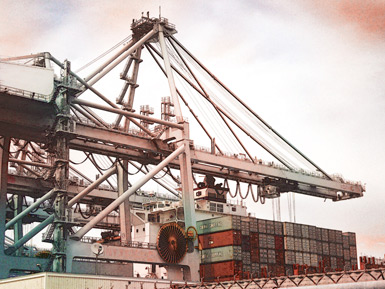Frontline: West Coast Ports Unite to Solve Challenges
Q3 2015

“Voyage times between Asia, Australia, and New Zealand are already lengthy. When you add two, four or more days because of delays on the West Coast, it makes a difference to shelf-life requirements for commodities,” says Fred A. Sorbello, CEO of The Mullica Hill Group, part of the AGRO Merchants Group. Mullica Hill Cold Storage is the largest receiver of meat in the United States.
In an unprecedented step, the Ports of Los Angeles and Long Beach - rival seaports - are working together via an agreement that allows both ports to cooperate far more strategically on finding new ways to prevent congestion and cargo delays, improve the transportation network, and enhance environmental sustainability and security.
Despite the ratified agreement, manufacturers are certain that strikes and delays will continue at West Coast ports.
Rival Seaports Working Together
Executives at the Ports of Los Angeles and Long Beach report that seaports also face other congestion-related challenges, particularly those caused by processing the ever-increasing number of supersized ships. Consequently, in an unprecedented step, these rival seaports are working together via an agreement approved by the Federal Maritime Commission (FMC) that allows both ports to cooperate far more strategically on finding new ways to prevent congestion and cargo delays, improve the transportation network, and enhance environmental sustainability and security.
“Essentially, the ports can now talk about everything — except price and terms,” says Phillip Sanfield, Port of Los Angeles spokesperson.
Already a series of meetings hosted by the ports have been held between cargo owners, trucking firm leaders, longshore labor, marine terminal operators, and other goods movement industry representatives.
“Now we’re forming seven working groups to focus on improvements in peak season 2015, container terminal optimization, chassis ops, off-dock solutions, key performance indicators/data solutions, intermodal rail, and drayage,” reports Art Wong, Port of Long Beach spokesperson. “Working with us will be our key stakeholders: shipping lines, cargo owners, labor, railroads, trucking interests, equipment owners, and more.”
Similarly, the Seattle and Tacoma port commissions have plans to form a Northwest Seaport Alliance that will unify management of the two ports’ marine cargo terminals and related functions. During a joint public meeting on June 5, both ports voted on the final agreement to be submitted to the Federal Maritime Commission (FMC)
“Barring unforeseen circumstances, the agreement should be up and running August 1,” says Bari Bookout, director of Commercial Strategy at the Port of Seattle.
While both seaports have cooperated on a number of fronts for many years, competition has increased dramatically causing the seaports to look for a more formal way to do business together.
“We have been competitors for a long time,” comments Bookout. “But in reality, shippers and steamship lines look at us as one gateway.”
By combining the two ports’ marine cargo operations, port officials believe the Northwest region would be in an even stronger position to address competitive challenges and create new economic opportunities.
“It will allow us to leverage our investments more strategically and handle the big ships being deployed,” she concludes.
Project Announcements
Australia-Based Aquatic Leisure Technologies Group Plans Opp, Alabama, Manufacturing Operations
12/11/2025
Teradyne Plans Wixom, Michigan, Robotics Operations
12/11/2025
Robinson Plans Altoona, Iowa, Manufacturing Operations
12/11/2025
BioTouch Expands Columbus, Georgia, Operations
12/11/2025
Natrion Plans Erie County, New York, Battery Components Operations
12/11/2025
Czech-Based GZ PrintPak Expands Mount Pleasant, Wisconsin, Manufacturing Operations
12/11/2025
Most Read
-
The Workforce Bottleneck in America’s Manufacturing Revival
Q4 2025
-
Rethinking Local Governments Through Consolidation and Choice
Q3 2025
-
Lead with Facts, Land the Deal
Q3 2025
-
How Canada Stays Competitive
Q3 2025
-
Investors Seek Shelter in Food-Focused Real Estate
Q3 2025
-
America’s Aerospace Reboot
Q3 2025
-
The Permit Puzzle and the Path to Groundbreaking
Q3 2025



